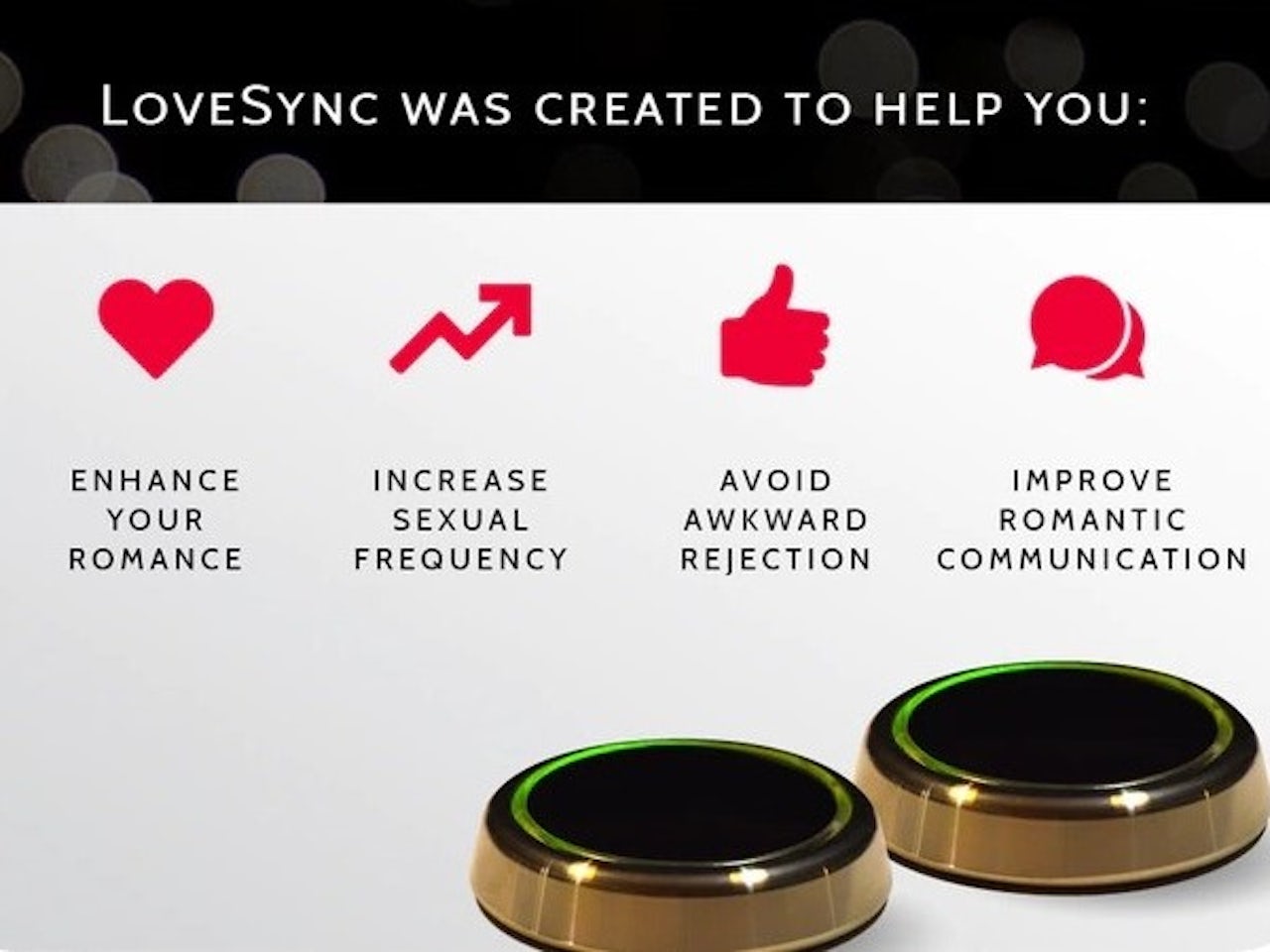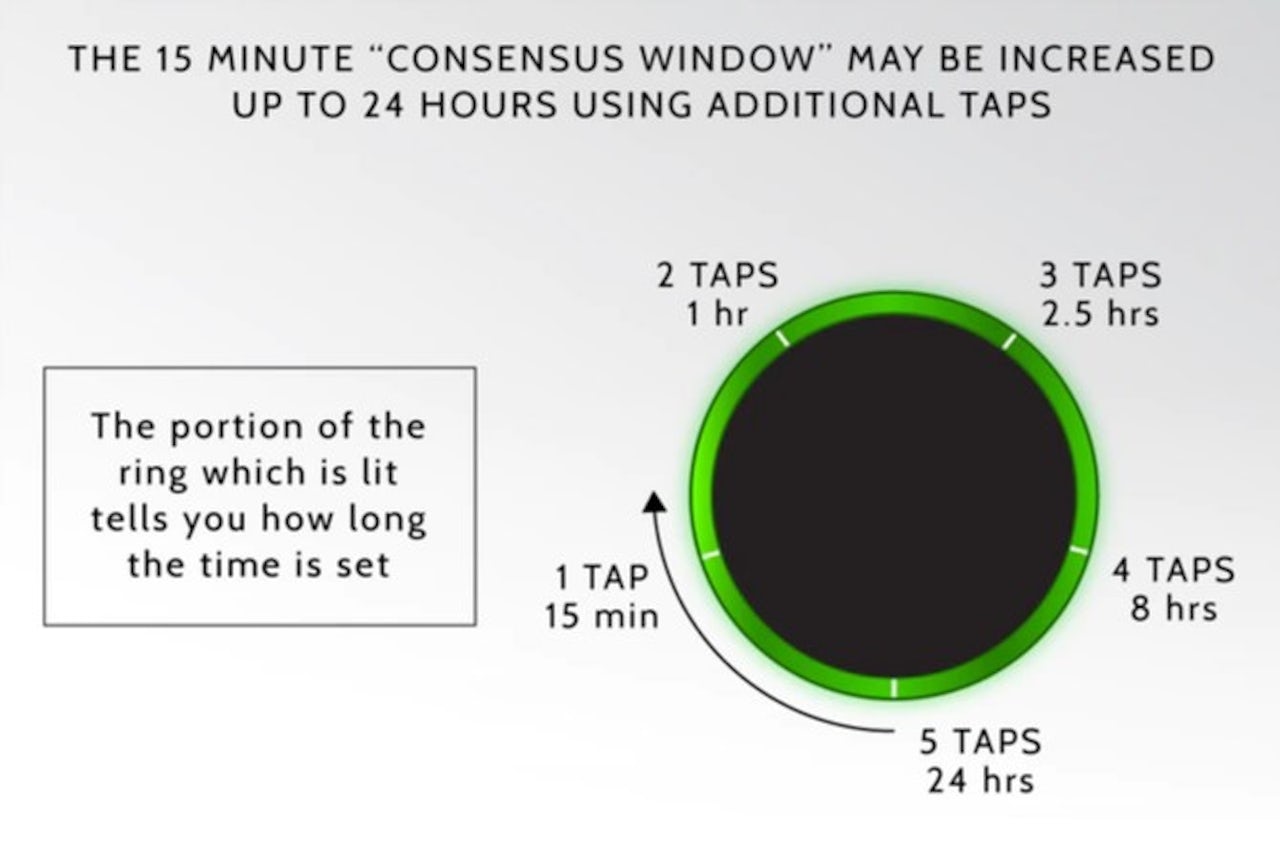Picture this: You’re horny. Your partner sits next to you, engrossed in a private world of content provided to them by their internet-connected device. Are they consuming video? Audio? Text? A game? It does not matter, to you, a horny person, for the only content you wish they would consume is your own carnal desire. But how will you ever know if they, at this very moment, share these sexual feelings? You could roll over and playfully nuzzle them, reading their body language with the studied, intimate care that only you, the person who has been with them for years in times both tough and tender, can. Or you could ask them.
But no! Think of the potential rejection, the shame, the awkwardness! You cannot. You shall not. Instead, your slip your hand under the covers, covertly slide it to the bedside table, feeling and fumbling until you grasp the cool, circular comfort of the LoveSync button.
You press it, indicating that for the next 15 minutes, you are up for some sex. Your partner has a LoveSync of their own; perhaps they have already pressed theirs. If so, your love has officially synchronized, the buttons will glow, and you now can both be assured that you would like to make a fuck. If not, the 15 minutes will pass, and you will both drift to sleep, your partner none the wiser of your horniness. But! They just might press their LoveSync before the window of sexual opportunity closes and/or one of you falls asleep, and a fuck, the fuck, can still be made.
If you are the type of person who is extremely on Twitter, you may be aware that the LoveSync sex button system is all too tragically real. Like every great social innovation from the abolition of witch-burning to the advent of the printing press, the LoveSync is a Kickstarter project, created by a couple named Ryan and Jenn Cmich. They are from Ohio, and a quick scan of the internet reveals that Ryan Cmich works in robotics and holds patents on an autonomous lawnmower and a “three-stage snow thrower,” which as someone who grew up in the South I cannot even begin to conceptualize (I had less success finding publicly available info on Jenn Cmich).
What I can conceptualize, however, is the idea that for $57, you and your partner can order a set of LoveSync buttons, and they will arrive in August. It can’t be a coincidence that the Cmiches launched the Kickstarter page the week of Valentines Day — I can imagine at least one of the Kickstarter’s backers consisting of a couple who plunked down an order, giggled at what a goofy thing they just dedicated money to, and then had sex without pushing any buttons. If this is something that occurred, then the LoveSync did its job.
Obviously the sex button is kind of dumb, and obviously, there is an argument to be made that the existence of a sex button is some sort of karmic punishment we deserve for being complicit in this age of increasingly techno-capitalist isolation. But one more thing is obvious: When you’re pushing buttons on a keyboard to form sentences complaining that the LoveSync sex button is stupid, those buttons will not help you and your partner have sex. Take that, dweeb.
There is, however, one practical application of the LoveSync that that comes to mind: couples who are actively attempting to conceive a child might find it genuinely useful. This would be a case in which both partners are trying to have as much sex as they can in a limited time period, and a button seems like an elegant solution for letting the other person you’re in “Go Mode.” (As you all know, saying you’re in “Go Mode” is the sexiest way to say you’re ready to have sex.) I can also see them functioning not as a constant presence on a couple’s respective bedside tables, but as kind of a sex toy for beginners, something to pull out during romantic getaways and honeymoons. Who knows, y’know?
Additionally, the LoveSync Kickstarter cites quotes from a pair of sex therapists, each of which point to discrepancies in libido — in layperson’s terms, unaligned horny levels — being a genuine issue for couples. It’s totally possible that the LoveSync is not unlike the weighted blanket, a therapeutic tool meant to serve a specific purpose that has taken on a life of its own when removed from its original context. As a long-term solution to keep a couple that’s become alienated from each other’s bodies on a robotic sex schedule, the LoveSync seems insane. As a bridge for helping couples become more comfortable expressing their sexual desires out loud, well: Do you have a better idea than a sex button?
Am I saying I want the sex button for myself? No. Am I saying the sex button is for you? Also no. (Unless you think the sex button is for you, in which case, yes, I am saying the sex button is for you.) My point is that the fact that some people have ordered the LoveSync is proof that the sex button is for some people, and they may want it for reasons we cannot imagine. Everyone likes their sex a little differently, and as long as they and their partner(s) are engaging in safe and consensual acts, it’s not our place to judge. Plus, this truly is the tip of the iceberg when it comes to sex-related products, so in the grand scheme of things, having a sex button isn’t a big deal. No, I’m not going to provide you with links to other sex stuff.
When I first saw the link to the LoveSync Kickstarter, my immediate reaction was to assume it was either some sort of stunt cooked up for the next season of Nathan for You or a guerrilla marketing campaign created by a brand attempting to project an “edgy” image. (Tinder? Trojan condoms? Netflix?) Marketing has evolved past corporations blasting ads in our faces, to a subtler world in which brands try to entertain, befriend, or even baffle us, all in an attempt to remind us that they exist and we should give them money for recognizing that we’re too clever to fall for their advertising. Nowadays, the most sophisticated marketing campaigns toggle between manipulation and commentary, and in turn, many of us have become increasingly vigilant whenever we log on, always cognizant of the fact that at any moment online, the rug might be pulled out from under us.
Under the harsh lights of sudden virality, we assume that nothing is just weird or goofy for its own sake; peel enough layers back, and there must be an agenda. While a healthy dose of skepticism is good, it’s easy to take this mindset too far and become convinced that everything and everyone around us doesn’t exist in the same reality that we do. If only there were, say, a button that we could push to let us know either way.



